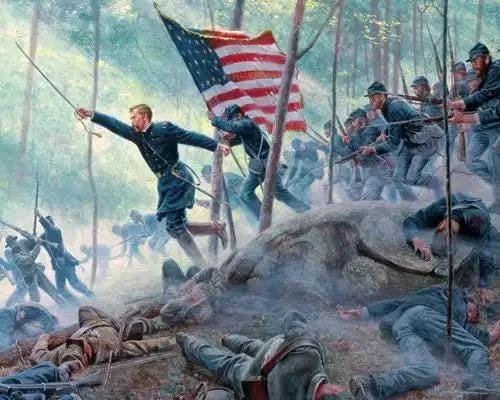Revisting "The Killer Angels"
Michael Shaara's extraordinary account of the Battle of Gettysburg
I’m back! Thanks for being patient while I spent a few weeks away from “What’s Gone Right.” It was great to hear from many of you while I was away. I look forward to getting back into a regular set of posts — a short reflection on Fridays about historical books, movies, and podcasts, and a longer story on Sundays. Enjoy!
For many years, I marked the 4th of July by re-reading one of my favorite historical fiction novels, Michael Shaara’s The Killer Angels, a heart-thumping, day-by-day account of the Battle of Gettysburg. It had been a while since I last read it, so I picked the book up again this week. It’s just as powerful as I had remembered.
The scrappy son of Italian immigrants, Michael Shaara was many things before he turned to writing – a boxer, a cop, a sergeant in the 82nd Airborne Division during the Korean War. He spent the 1950s churning out science fiction stories and teaching writing at Florida State while raising two kids, Jeff and Lila (both of whom grew up to be writers). His first novel, The Broken Place (1968), about a Korean War veteran who becomes a boxer, failed to win commercial success. But Shaara kept writing.
After a family trip to Gettysburg, he spent seven years researching and writing The Killer Angels. Fifteen publishers — 15! — rejected the manuscript before a small indie press took a chance on it. The book unexpectedly won the 1975 Pulitzer Prize for Fiction, though it didn’t sell well until after the release of the popular 1993 film, “Gettysburg” (five years after Shaara’s death). [1]
The book spans just five days, from June 30 to July 3, 1863. Confederate Gen. Robert E. Lee had invaded Pennsylvania, hoping to break Union morale by taking the Civil War to the North. Lee’s Army of Northern Virginia and Union Maj. Gen. George Meade’s Army of the Potomac – about 165,000 men in all – faced each other across the rolling terrain outside Gettysburg, then a town of barely 2,400. Shaara walks readers through each day, telling the story of the battle through the eyes of those who fought in it, Union and Confederate alike.
The Killer Angels introduced me to the heroic Bowdoin College professor who volunteered for the Union and rose to become a brigadier general: Joshua Chamberlain. Shaara’s depiction of Chamberlain and his 20th Maine Regiment’s July 2 defense of Little Round Top stirs me still, even after reading it half a dozen times. Their spirited bayonet charge to protect the extreme left wing of the Union line repelled the rebels, forcing Lee to try a desperate, and unsuccessful, attack on the broad middle of the Union line the next day. By July 4, the Union had claimed victory. The Confederates never again fought beyond the Mason-Dixon Line.
The book is a remarkable work of historical research and imagination. Shaara gives us plenty of details about tactics, troop movements, and casualties — more than 50,000, including more than 7,000 dead. But he focuses on humanity of the men who fought: their emotions, their vulnerabilities, their stories. He helps readers appreciate the steep price that real human beings paid to preserve the Union and ultimately end slavery. It’s worth a read this Independence Day.
Sources
[1] Shaara, Jeff. “Michael Shaara.” https://jeffshaara.com/michael-shaara/






I just read "Killer Angels" in preparation for visiting Gettysburg last week. I loved the book -- and it made me see the battlefields with an informed eye and an open heart. It's also a great help in getting me through Sears's "Gettysburg." You really get to know the generals. . . and sympathize with almost all of them, Yankees and Rebels alike.
Reading about the Maine battalion, admiring Chamberlain, and with Midcoast one of my favorite places, I immediately thought, Well, of course Mainers would name a hamlet after Chamberlain.
It's very near the Rachel Carson Salt Marsh.
It was some war. But as one historian in Ken Burns's documentary observed, Before the Civil War, people said "The United States are"; and now we say "The United States is."
One of my favorite books too. I read it in high school. Had a great history teacher who was a huge Civil War buff and writer himself.